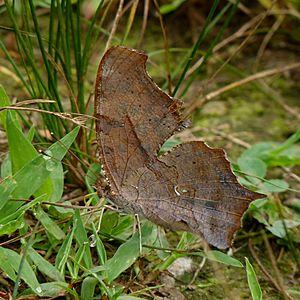Question mark (butterfly) facts for kids
Quick facts for kids Question mark |
|
|---|---|
 |
|
| Upperside | |
 |
|
| Underside | |
| Conservation status | |
| Scientific classification | |
| Synonyms | |
|
Nymphalis interrogationis |
The question mark (Polygonia interrogationis) is a cool butterfly found in North America. It gets its name from a special mark on the underside of its wings that looks like a question mark!
This butterfly likes to live in places with both trees and open spaces, like forests and city parks. Its wings are colored and textured to look like a dead leaf. This helps it hide from animals that might want to eat it. Adult question mark butterflies have a wingspan of about 4.5 to 7.6 centimeters (1.8 to 3 inches). You can usually see them flying from May to September.
Contents
Life Cycle of the Question Mark Butterfly
Like many other insects, the question mark butterfly goes through four main life stages. This process is called complete metamorphosis. The four stages are:
- Egg (ova)
- Caterpillar (larva)
- Chrysalis (pupa)
- Adult butterfly (imago)
Eggs and Hatchlings
After a male and female butterfly mate, the female lays her eggs. She usually places them one by one or in small stacks under leaves. These leaves are often not the ones the young caterpillars will eat. Once the tiny caterpillars hatch, they must find their own food source to survive.
Growing as a Caterpillar
Question mark caterpillars grow through several stages called instars. At the end of each instar, the caterpillar sheds its old skin. This is like taking off a too-small shirt! A new, bigger skin forms underneath. This new skin then expands and gets its color.
During their last instar, the caterpillars start to develop the patterns that will become their adult butterfly wings.
Caterpillar Food Plants
Question mark caterpillars are not picky eaters! They can munch on leaves from many different plants. Some of their favorite host plants include:
- American elm (Ulmus americanus)
- Red elm (Ulmus rubra)
- Hackberry (Celtis species)
- Japanese hop (Humulus japonicus)
- Nettles (Urtica species)
- False nettle (Boehmeria cylindrica)
Becoming a Chrysalis
Once a caterpillar has grown enough, it turns into a chrysalis. This is the pupa stage. Unlike many moths that build cocoons, butterfly pupae are usually "naked." This means they don't have a protective covering like a cocoon.
When the caterpillar sheds its skin for the last time, it becomes a soft chrysalis. If you look closely, you can sometimes see parts of the future butterfly forming inside. As the chrysalis hardens, it takes on colors that match its surroundings. This helps it stay hidden from predators. After several days or a few weeks, the adult butterfly emerges, usually in the morning or afternoon.
Adult Butterfly Life
As an adult butterfly, the question mark doesn't usually drink nectar from flowers. Instead, it prefers to find food like:
- Rotting fruit
- Tree sap
- Animal droppings (dung)
- Dead animals (carrion)
They only visit flowers for nectar if their favorite foods are not available. This special diet helps them survive, especially in early spring or late fall when there aren't many flowers blooming.
Where They Live and Travel
You can find the question mark butterfly in southern Canada and most of the eastern United States. They live as far west as the Rocky Mountains and south into Arizona and Mexico. These butterflies are also known to migrate, meaning they travel long distances.
When They Fly
Question mark butterflies have different flight times depending on the season.
- The first group of adults flies and lays eggs in the spring, usually until the end of May.
- The summer adults emerge and fly from May to September. They lay eggs that will develop into the "winter form" butterflies.
- These winter form adults appear in late August and spend the cold months in sheltered spots.
Gallery






